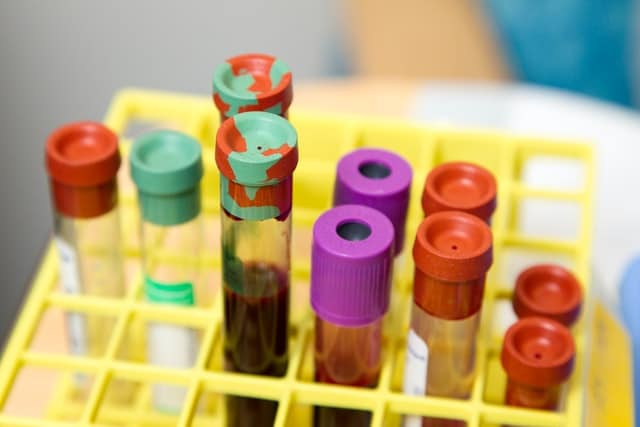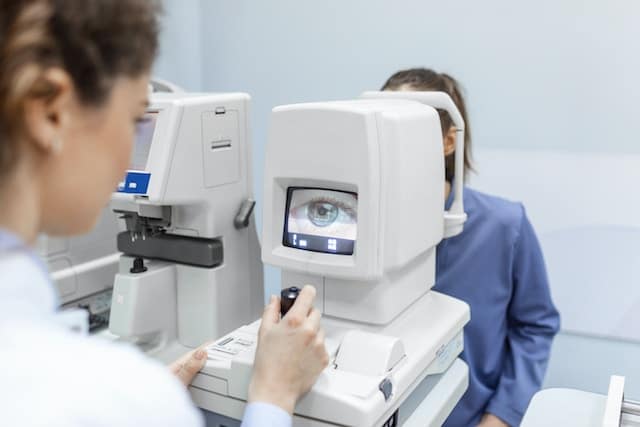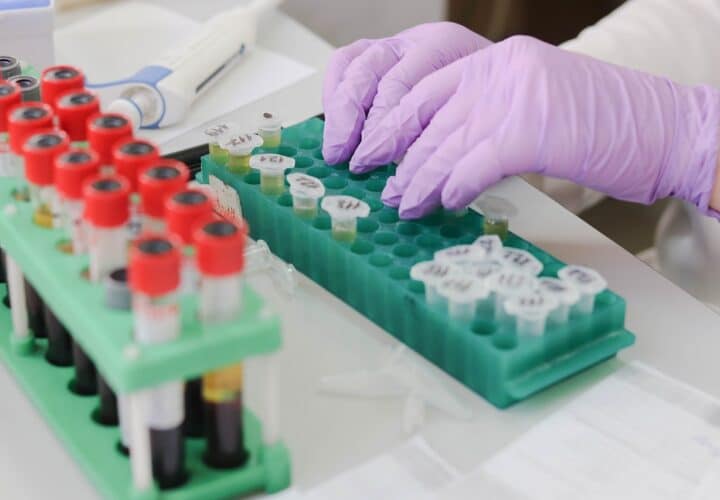Blood tests that screen for biomarkers of Alzheimer's disease are growing more widely available. But the results can be very tough to interpret. Here’s what you need to know.
An Alzheimer’s blood biomarker test can’t actually determine whether or not a person has Alzheimer’s disease — but it can help signal to doctors the presence of biomarkers, encouraging helpful lifestyle changes or leading to earlier diagnosis. Alzheimer’s blood biomarker tests themselves can’t actually determine whether or not a person has Alzheimer’s disease but can be used as part of a diagnostic workup to help make a diagnosis. Quest’s test was the only one made available direct to consumers, but as of March 12, 2024, the test is no longer offered directly to patients. This decision was influenced by communications with the Alzheimer’s Association and other biomarker researchers according to MedPage Today.
Anyone looking over their results themselves will see a jumble of information that’s not so easy to interpret.
Since these tests are new, understanding what the results mean can be extra confusing, according to Madhav Thambisetty, neurologist and senior clinical investigator at the National Institute on Aging told Being Patient. There are a couple factors at play. One is that the industry hasn’t agreed on any standardized benchmarks for what makes a test “positive” or “negative” for Alzheimer’s biomarkers. Then, Thambisetty, there’s the diversity issue: The tests haven’t really been tested in much of the population, particularly people of color.
“Most studies reporting the performance metrics of these tests are from observational cohorts or clinical trials that do not enroll a diverse population of individuals representing patients typically seen in memory clinics,” Dr. Thambisetty told Being Patient.
Another wrinkle: As with any bloodwork, external factors could affect your blood test results. Thambisetty said more study is needed to really understand how well these tests work in the real world, and to understand how these blood tests are influenced by coexisting conditions (like heart disease or depression), or other medications.
Factors that affect your blood test results
Recent research has highlighted that measuring protein biomarkers in the blood isn’t as simple as it sounds. Certain medications can potentially lead to false positive or false negative results — since the tests were developed using a cohort of Alzheimer’s patients who didn’t have other health conditions, it can make interpreting the results in the real world more difficult.
The Aβ42/40 ratio is affected by a common heart medication called Entresto (generic name: sacubitril/valsartan). Someone taking this medication would have a lower ratio of these biomarkers, which could lead to a false positive test result. The changes in the Aβ42/40 ratio caused by the drug are three times as big as the changes scientists expect to see when a healthy person starts to develop Alzheimer’s disease.
The “normal” levels of other protein biomarkers also vary between individuals. A recent study found that even healthy individuals can sometimes have unusually high levels of Alzheimer’s plasma biomarkers. Other biomarkers like neurofilament light chain (NfL) are so different between healthy individuals that it is hard to tell whether a measurement is “high” or “low.” Even the levels of p-tau biomarkers may vary day-to-day in healthy individuals.
Interpreting the results of Precivity AD™
After taking the test, you will receive an Amyloid Probability Score (APS), calculated using the company’s proprietary risk algorithm based on the ratio of Aβ42/40 proteins in the blood and their APOE status. This is a number between zero and 100 that predicts whether there is beta-amyloid pathology in the brain.
Negative result
A negative result occurs when the APS score is between zero and 35. It indicates a low likelihood of amyloid plaques in the brain, which can sometimes rule out Alzheimer’s as the cause of a patient’s cognitive symptoms. Doctors can then look for other potential causes of cognitive symptoms like vitamin or hormone deficiencies or other forms of dementia instead.
Uncertain result
Some people will not get a clear positive or negative result based on this test. If the score is between 36 and 57, it suggests that more testing is needed to figure out if a patient may have Alzheimer’s pathology in the brain.
Positive result
A high score of 58 or higher is considered a positive result. It indicates a high likelihood of amyloid pathology in the brain. However, it is not sufficient on its own to make the final Alzheimer’s diagnosis.
Interpreting the results of Precivity AD2™
After taking the test, you will receive an Amyloid Probability Score 2 (APS2) calculated using a proprietary algorithm based on the ratio of Aβ42/40 and pTau-217/npTau-217 proteins in the blood. Like the APS score, it is a number between zero and 100 that predicts whether there is beta-amyloid pathology in the brain.
Negative result
A negative result occurs when the APS2 score is between 48 and 100. It suggests a low chance that the person being tested has beta-amyloid plaques in the brain. Doctors may want to explore other potential causes of cognitive decline.
Positive result
A positive APS2 result occurs when the score is between 0 and 47. It means there is a high likelihood that a person has amyloid plaques in the brain. However, the result is not sufficient on its own to diagnose Alzheimer’s.
Interpreting the results of the Lucent AD p-tau181 test
CEO Masoud Toloue says this is used as a test to rule out Alzheimer’s.
Negative result
If the levels of pTau-181 in the blood are below 14.2pg/mL, the test returns a negative result, ruling out Alzheimer’s disease.
Positive result
If the levels of pTau-181 in the blood are equal to or above 14.2pg/mL, the test cannot rule out Alzheimer’s disease. Other neurological or imaging tests are required to make an accurate diagnosis.
Interpreting the results of the Lucent AD p-tau217 test
LucentAD declined to provide the cutoffs for a negative and positive test.
Interpreting the results of Labcorp’s ATN test
The ATN test measures three different biomarkers of Alzheimer’s disease in the blood to see if the biomarkers are above or below a certain threshold and are likely to have amyloid and tau in their brains:
- Aβ42/40 ratio is less than 0.102
- pTau-181 levels are higher than 0.97 pg/mL
- NfL levels are higher than 7.64 pg/mL
It is unclear how to interpret test results when only one or two of these biomarkers are above a certain threshold.
Interpreting the results of Labcorp’s pTau-217 test
The test will detect the level of pTau-217 in the blood to determine whether the levels of this Alzheimer’s biomarker are indicative of brain pathology.
Negative result
A negative result occurs when the levels of pTau-217 are within 0 to 0.18 pg/mL. This result suggests that there is a low likelihood of amyloid plaques in the brain and that potential cognitive symptoms might be attributed to other conditions.
Positive result
When pTau-217 levels are higher than 0.18 pg/mL it indicates that a patient may have amyloid pathology in the brain. However, on its own to make the final Alzheimer’s diagnosis.
Interpreting the results of Quest Diagnostics AD-Detect test
Based on the ratio of Aβ42/40, the test tells people if they are likely to have beta-amyloid plaques and Alzheimer’s pathology in their brains.
Negative result
People with a ratio greater than 0.170 are considered to have a low risk of having Alzheimer’s pathology in their brain.
Intermediate result
People with a ratio between 0.150 and 0.169 have a medium risk of beta-amyloid pathology in the brain.
Positive result
People with a high risk have a ratio of less than 0.150. Note that this test result alone cannot diagnose Alzheimer’s disease.
Interpreting the results of ALZpath ALZpath Dx test
Based on the level of pTau-217, the test tells people if they are likely to have beta-amyloid plaques and Alzheimer’s pathology in their brains. Unlike other blood tests, this one can be used in lieu of a lumbar puncture or amyloid PET scan to provide a diagnosis.
Negative result
People who have less than 0.34 pg/mL of pTau-217 in their blood receive a negative test result indicating they do not have Alzheimer’s pathology in the brain.
Intermediate result
Approximately 10 to 15 percent of the time, the test will return an intermediate result. This means that the levels of pTau-217 in the blood are between 0.34 and 0.47 pg/mL.
“For patients in the intermediate zone, we recommend re-testing within six to 12 months, or following-up with a standard lumbar puncture, or amyloid PET imaging, depending on the clinical presentation,” Andreas Jeromin, chief scientific officer of ALZpath told Being Patient.
Positive result
People who have at least 0.48 pg/mL of pTau-217 in their blood have Alzheimer’s pathology in the brain. Taken together with the results of other cognitive tests, this can help a doctor make an Alzheimer’s diagnosis.
Interpreting the results of Eli Lilly’s CertuitAD Test
Based on the level of pTau-217, the test tells people if they are likely to have beta-amyloid plaques and Alzheimer’s pathology in their brains. Eli Lilly declined to disclose the thresholds that define a negative, indeterminate, and positive result ahead of their peer-reviewed scientific publication.
Negative result
This indicates that the person being tested does not not have Alzheimer’s pathology in the brain.
Intermediate result
Approximately 18 percent of the time, the test will return an indeterminate result. Doctors might need to rely on other tests to determine whether a person may have amyloid plaques in their brain.
Positive result
This indicates that the person being tested likely has Alzheimer’s pathology in the brain. This result can be used in conjunction with other laboratory and cognitive assessments to help diagnose the disease.
So, what do the results mean for me?
Blood tests are not some magical solution that makes an Alzheimer’s diagnosis fast and easy. These blood tests — like any other laboratory test — provide another piece to the diagnostic puzzle, according to Thambisetty.
“As a practicing clinician, any test that I order for evaluation of a patient with memory concerns is guided by the data I obtain from a thorough clinical history (both from the patient as well as family member/caregiver), assessment of all medications the patient is taking, consideration of comorbid medical conditions, a detailed neurological examination and cognitive testing,” he said.
Ultimately, how well these tests work in the real world is still unclear, and more research is needed.
UPDATED – APRIL 25, 12:48 PM EST: Added information about Eli Lilly’s blood test.
UPDATED – APRIL 2, 1:40 PM EST: Added information about the ALZpath Dx and Labcorp pTau-217 blood test which were released after the initial publication of the article. As of March, Quest Diagnostic’s test is also no longer offered direct to patients and must now be ordered through a doctor.





Is Alzheimer’s treated with Intravenous Chelation? Is there any Intervenous medication treatments for Alzheimers